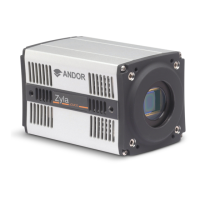version 2.0 rev 18 Feb 2021
18
2.2.1 Rolling Shutter
InRollingShuttermode,adjacentrowsofthearrayareexposedatslightlydierenttimesasthereadout
‘waves’ sweep through each half of the sensor. Therefore, each row will start and end its exposure slightly
osetintimefromitsneighbour.InthecaseoftheZyla5.5,atthemaximumreadoutrateof560MHz(aseach
halfofthesensorisat280MHz),thisosetbetweenadjacentrowexposuresis~10μs.Therollingshutter
readout mechanism is illustrated in Figure 8 below. From the point of view of readout, the sensor is split in half
horizontally.Rowsarereadoutfromthecentreoutwards,rowafterrow.Atthestartofanexposure,thewave
sweeps through each half of the sensor, switching each row in turn from a ‘keep clean state’, in which all charge
is drained from the pixels, to an ‘exposing state’, in which light induced charge is collected in each pixel. At the
end of the exposure, the readout wave again sweeps through the sensor, transferring the charge from each
row into the readout node of each pixel. The important point is that each row will have been subject to exactly
the same exposure time, but the row at the top (or bottom) edge of the sensor would have started and ended
itsexposure~10ms(1080rowsx10μs/row)aftertherowsatthecentreofthesensor(whenusing560MHz
readout rate).
Figure 8: Rolling Shutter Exposure and Readout
Rolling shutter can be operated in a ‘continuous’ mode when capturing a kinetic series of images, whereby
after each row has been read out it immediately enters its next exposure. This ensures a 100% duty cycle,
meaning that no time is wasted between exposures and, perhaps more importantly, no photons are wasted.
Atthemaximumframerateforagivenreadoutspeed(e.g.100fpsat560MHzfortheZyla5.5)thesensor
is continuously reading out, i.e. as soon as the readout fronts reach the top and bottom of the sensor, they
immediately return to the centre to readout the next exposure.
A potential downside of rolling shutter is spatial distortion resulting from the above described exposure
mechanism. This has historically been more apparent in devices such as CMOS camcorders, where the entire
imageeldcouldbemoved(forexamplebytheuserrapidlypanningthecamera)ataratethattheimage
readout could not match; thus, objects could appear at an angle compared to their actual orientation. In
reality,despitethetime-osetreadoutpattern,rollingshuttermodeisappropriateforthemajorityofscientic
applications, especially where the exposure time is equal to or greater than the sensor readout time, discussed
later.

